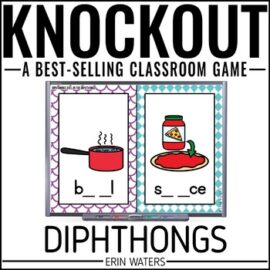You know that feeling. There's an almost audible buzz circulating your classroom–feet tap anxiously, students whisper nonsensical messages when they should be working, and discovery of miscellaneous objects–staples and paper scraps galore–found on the carpet is at an all-time high: It's time for a brain break. We all know GoNoodle is the go-to brain break option for the elementary classroom. There's a good reason for that: it is quick, easy, free, and best of all: it inspires movement! While GoNoodle is great, and I would never teach without it, sometimes you just need to switch things up.
Brain Break Idea #1: Stop, Drop, & Talk
This one is as simple as they come, and a great way to discourage chit-chat during instructional time. Sometimes, kids and adults alike just need to get their wiggles out–or in this case, their chitchat out. If you notice your kids are extra chatty and can't seem to focus on the task at hand, then Stop, Drop, + Talk is your answer. You can give your class a visual cue (like turning off the lights) and simply announce: “Stop, Drop, and Talk.” Using a SmartBoard timer or your classroom clock, give your class 1-2 minutes to talk to a friend in the class. Once the period is over, kids return to the assigned task with a renewed focus.

Brain Break Idea #2: Exercise Class
This is one of my favorites because it involves student leadership and physical movement. Select a student to lead their peers in an “exercise class.” This is a revised version of ‘Simon Says,' in which the entire class follows the leader's verbal and physical cues. The leader may instruct their peers to do 10 jumping jacks, 5 sit-ups, and so on. Continue this for 3-5 minutes.
Brain Break Idea #3: Dance Party
This one does not require much explanation, and can be adjusted to fit your classroom needs. No visual cue is needed to start this brain break; instead, play music that the entire class can hear. I love using my phone and a Bluetooth speaker to play KidsBop (this one is my current favorite), or find a Youtube video featuring kids' music–just don't show the video or else kids will forget they are supposed to be dancing!
Brain Break Idea #4: One Word Game
While not necessary, it's always nice to find a brain break activity that combines fun and academics. One Word Game is quite simple and you only need 2 chairs, a whiteboard, and kids to play! Using these One Word slides (or you can draw your own), 2 students sit facing the class with their backs to the whiteboard. An image is shown on the screen that only the audience can see. Split into 2 teams (down the middle of the crowd of students), students take turns giving their peer a clue about the image on the screen behind them. The catch? They can only use ONE word in each clue. Build vocabulary and language skills, along with teamwork and sportsmanship–that's what I call a win-win.
Brain Break Idea #5: Freeze Frame
The teacher leads this game, at least in the younger grades. As students become more accustomed to this game, or are a bit older, a student can lead. The teacher calls out a category; for example, “animals with fur.” She then slowly names a list of animals in that category as students walk safely around the room. When the teacher names an item that does not fit into that category, the students freeze. The game continues as long as the teacher leads it, switching up categories every so often.
Brain Break Idea #6: Zoom
This one is a class favorite. Sitting or standing in a circle, choose one student to start the “Zoom Chain.” As soon as that student says, “Zoom,” the student to his left says it as quickly as possible; then, the student to his left says it as quickly as possible, and so on. The goal here is to see how quickly the circle of students can pass the word around. After a few practice rounds, it's super exciting to time the class to see if records can be set and broken throughout the year.
A Brain Break Caveat
Like any classroom activity or routine, it is crucial that you lay out clear expectations for your students prior to jumping into any of these activities. I strongly recommend role-playing each activity with a small group of students first. In addition, a few “practice rounds” are nice to get any kinks out of the plan. Finally, be sure to reinforce the purpose of brain breaks throughout the year: while they are fun, their purpose is to allow students to return to a classroom job more on-task and focused. Behavior that results in students being less focused once the brain break is done will not be tolerated.
Want fresh ideas weekly AND a $10 gift card to use on teaching resources? Click here to sign up for my VIP teacher club–it's free!










 Arm you with high-quality tools: Sleep peacefully at night knowing you’re doing what’s best for your students.
Arm you with high-quality tools: Sleep peacefully at night knowing you’re doing what’s best for your students. Save your energy: Provide resources that cost you little energy (that stuff is precious)---but have high impact on your students.
Save your energy: Provide resources that cost you little energy (that stuff is precious)---but have high impact on your students. Light your spark: Putting fun back into your classroom after the hardest teaching years can be just what you and your students need.
Light your spark: Putting fun back into your classroom after the hardest teaching years can be just what you and your students need.
Leave a Comment